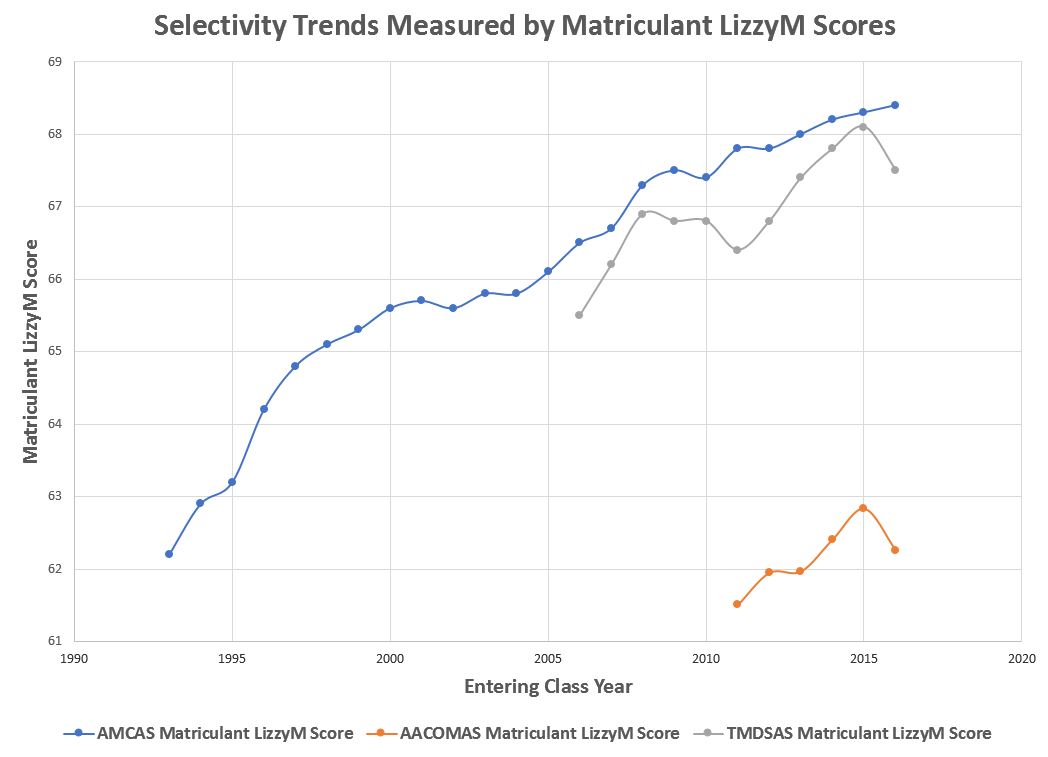- Joined
- Jun 17, 2014
- Messages
- 63,099
- Reaction score
- 154,760
Recently we have had a few threads and active discussion regarding recent the score creep in academic metrics. I would like to organize everything neatly into one clean thread based on these findings. More specifically, I wanted to focus on general competition and selectivity trends seen in US MD (AMCAS), US DO (AACOMAS) and Texas (TMDSAS) medical schools based on available public data.
Thanks to @LizzyM @gonnif @efle @Lucca @walloobi @libertyyne and the SDN community for active discussion, data analyses and collaboration.
Past threads and posts cited:
Applicants:
Internet Archive Wayback Machine
http://www.aacom.org/docs/default-source/data-and-trends/2011-14-AProfRpt.pdf?sfvrsn=26
http://www.aacom.org/docs/default-source/data-and-trends/2012-15-app-report.pdf?sfvrsn=10
http://www.aacom.org/docs/default-s...riculant-profile-summary-report.pdf?sfvrsn=10
TMDSAS Medical: Application Statistics
Matriculants:
Internet Archive Wayback Machine
https://www.aacom.org/docs/default-source/archive-data-and-trends/2011-Mat.pdf?sfvrsn=10
http://www.aacom.org/docs/default-source/data-and-trends/2012-15-matprofilerpt.pdf?sfvrsn=8
http://www.aacom.org/docs/default-s...riculant-profile-summary-report.pdf?sfvrsn=10
TMDSAS Medical: Application Statistics
Here are the results.
Trends in Total Number of Applicants and Matriculants
Solid lines represent total number of applicants; dashed lines represent total number of matriculants

Competition Trends
As per gonnif's definition, competition is defined as the applicant to seat ratio, so I divided total number of applicants by total number of matriculants.

Competition growth curves can be found by calculating the percentage change in competition between consecutive years. Negative percent change means competition has decreased; positive percent change means competition has increased; decreasing positive percent change means competition is slowing down.

Selectivity Trends
By gonnif's definition, selectivity is the academic and related metrics candidates are chosen on. To quantify selectivity, I used the matriculant LizzyM scores.

Selectivity growth curves can be found by calculating the percentage change in selectivity between consecutive years. Negative percent change means schools are becoming less selective; positive percent change means schools are becoming more selective; decreasing positive percent change means selectivity is slowing down.

Competitiveness Score Trends for US MD Schools (by @walloobi )
The competitiveness score represents how difficult it is to get into medical school at any given year (higher number = more difficult to get accepted).

Changes in difficulty in getting into US MD school can be found by calculating the percentage change in competitiveness scores between consecutive years. Negative percent change means it is easier to get accepted; positive percent change means it is harder to become accepted.

Relationship between Selectivity and Competition
Selectivity-competition curves can be found by plotting matriculant LizzyM scores against applicant to seat ratios. Arrows are pointed in direction of increasing competition and selectivity.
Curves shifted to the right indicate higher competition.
Curves shifted to the left indicate lower competition.
Curves shifted up indicate higher selectivity.
Curves shifted down indicate lower selectivity.

Enjoy! And feel free to leave your comments below.
Thanks to @LizzyM @gonnif @efle @Lucca @walloobi @libertyyne and the SDN community for active discussion, data analyses and collaboration.
Past threads and posts cited:
- gonnif's definitions of selectivity and competition
- Trends in LizzyM Scores Over Time
- TIL one decade ago, average MCATs at top medical schools were ~32-34
- efle's plots of applications, matriculants, GPA and MCAT data using AAMC Table A-16
- walloobi's work on measuring competitiveness
Applicants:
Internet Archive Wayback Machine
http://www.aacom.org/docs/default-source/data-and-trends/2011-14-AProfRpt.pdf?sfvrsn=26
http://www.aacom.org/docs/default-source/data-and-trends/2012-15-app-report.pdf?sfvrsn=10
http://www.aacom.org/docs/default-s...riculant-profile-summary-report.pdf?sfvrsn=10
TMDSAS Medical: Application Statistics
Matriculants:
Internet Archive Wayback Machine
https://www.aacom.org/docs/default-source/archive-data-and-trends/2011-Mat.pdf?sfvrsn=10
http://www.aacom.org/docs/default-source/data-and-trends/2012-15-matprofilerpt.pdf?sfvrsn=8
http://www.aacom.org/docs/default-s...riculant-profile-summary-report.pdf?sfvrsn=10
TMDSAS Medical: Application Statistics
Here are the results.
Trends in Total Number of Applicants and Matriculants
Solid lines represent total number of applicants; dashed lines represent total number of matriculants

Competition Trends
As per gonnif's definition, competition is defined as the applicant to seat ratio, so I divided total number of applicants by total number of matriculants.

Competition growth curves can be found by calculating the percentage change in competition between consecutive years. Negative percent change means competition has decreased; positive percent change means competition has increased; decreasing positive percent change means competition is slowing down.

Selectivity Trends
By gonnif's definition, selectivity is the academic and related metrics candidates are chosen on. To quantify selectivity, I used the matriculant LizzyM scores.

Selectivity growth curves can be found by calculating the percentage change in selectivity between consecutive years. Negative percent change means schools are becoming less selective; positive percent change means schools are becoming more selective; decreasing positive percent change means selectivity is slowing down.

Competitiveness Score Trends for US MD Schools (by @walloobi )
The competitiveness score represents how difficult it is to get into medical school at any given year (higher number = more difficult to get accepted).

Changes in difficulty in getting into US MD school can be found by calculating the percentage change in competitiveness scores between consecutive years. Negative percent change means it is easier to get accepted; positive percent change means it is harder to become accepted.

Relationship between Selectivity and Competition
Selectivity-competition curves can be found by plotting matriculant LizzyM scores against applicant to seat ratios. Arrows are pointed in direction of increasing competition and selectivity.
Curves shifted to the right indicate higher competition.
Curves shifted to the left indicate lower competition.
Curves shifted up indicate higher selectivity.
Curves shifted down indicate lower selectivity.

Enjoy! And feel free to leave your comments below.
Last edited:






